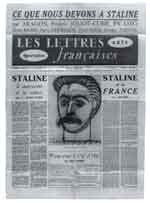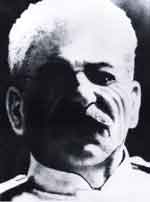|
"The drawing presumably arrived at Les Lettres françaises at the last minute before the edition was closed on the morning of 12 March. (...) Ignoring such suggestion for the caption as "Stalin's eternal youth", [Pierre] Daix [editor of the journal] opted for the neutral "Stalin par Pablo Picasso, 8th March 1953". (...)
The first negative reaction came from the employees of France Nouvelle and L'Humanité, the two papers, which shared the building as Les Lettres françaises. The workers were appalled by what they considered an affront to Stalin.
On seeing the journal, Elsa Triolet, [wife of Louis Aragon, the chief editor of the journal], the true militant, understood immediately that the simple fact that Picasso had dared to touch Stalin was going to infuriate the faithful, and she new that disaster awaited him. She realized that the perceptual discrepancy between the young Georgian on the drawing and the usual representation of the deceased as "the incarnation of wisdom, courage, of all that is human, of one who had won the war, our savior" was too wide for the believers. (...) During the postwar years Stalin embodied an idea that came as close to God as could be tolerated (...) Nothing could have better demonstrated the true extent of the quasi-religious cult that surrounded Stalin than the storm of protest the portrait generated. (...) On 18 March 1953, the following communiqué appeared in L'Humanité, under the title "Communication du Secrétariat du Parti Communiste Français": "The Secretariat of the French Communist Party categorically disapproves of the publication in Les Lettres françaises of 12 March, of the portrait of the Great Stalin by comrade Picasso." (...)
Aragon was obliged to publish the communiqué in the following number of Les Lettres françaises on 19 March 1953, as well as a self-criticism in L'Humanité. (...) The major reproach was that the portrait neglected to reflect the emotions of the public, "the love that the working class feel for the regretted comrade Stalin and for the Soviet Union", and that it did not do justice to the moral, spiritual, and intellectual personality of Stalin. (...) The ferocity of the ensuing scandal, which to this day is vivid in the minds of those active then, is difficult to comprehend today. (...) Not even the show-trials and the revelations about Stalin after his death were as divisive. (...)
In conversation with Pierre Daix, who was sent by Aragon to appease him, Picasso speculated: "Can you imagine if I had done the real Stalin, such as he has become, with his wrinkles, his pockets under the eyes, his warts . Can you hear the scream? He has disfigured Stalin. He has aged Stalin." He continued in a more salacious vein: "And then, too, I said to myself, why not a Stalin in heroic nudity? . Yes, but, Stalin nude, and what about his virility? . So small. . But come on, Stalin, he was a true male, a bull. So then, if you give him the phallus of a bull, and you've got this little Stalin behind his big thing they'll cry: But you've made him into a sex maniac! A satire! Then if you are a true realist you take your tape measure and you measure it all properly. That's worse, you made Stalin into an ordinary man. And then, as you are ready to sacrifice yourself, you make a plaster cast of your own thing. Well, it's even worse. What, you dare take yourself for Stalin! . After all, Stalin, he must have had an erection all the time, just like the Greek statues. ... Tell me, you who knows, Socialist Realism, is that Stalin with an erection or without an erection?"
Utley, Gertje R., Picasso: The Communist Years. Yale University Press: New Haven and London, 2000.
|




